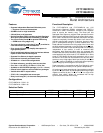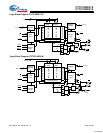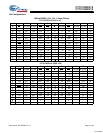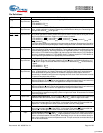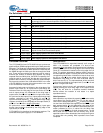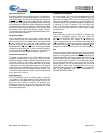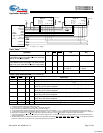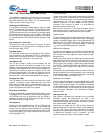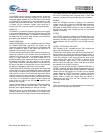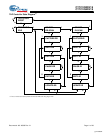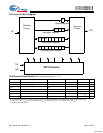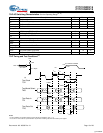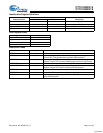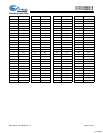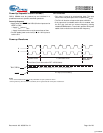
CY7C1292DV18
CY7C1294DV18
Document #: 001-00350 Rev. *A Page 5 of 23
Functional Overview
The CY7C1292DV18 and CY7C1294DV18 are synchronous
pipelined Burst SRAMs equipped with both a Read port and a
Write port. The Read port is dedicated to Read operations and
the Write port is dedicated to Write operations. Data flows into
the SRAM through the Write port and out through the Read
port. These devices multiplex the address inputs in order to
minimize the number of address pins required. By having
separate Read and Write ports, the QDR-II completely elimi-
nates the need to “turn-around” the data bus and avoids any
possible data contention, thereby simplifying system design.
Each access consists of two 18-bit data transfers in the case
of CY7C1292DV18 and two 36-bit data transfers in the case
of CY7C1294DV18 in one clock cycle.
Accesses for both ports are initiated on the rising edge of the
positive Input Clock (K). All synchronous input timings are
referenced from the rising edge of the input clocks (K and K
)
and all output timings are referenced to the rising edge of
output clocks (C and C
or K and K when in single clock mode).
All synchronous data inputs (D
[x:0]
) inputs pass through input
registers controlled by the input clocks (K and K
). All
synchronous data outputs (Q
[x:0]
) outputs pass through output
registers controlled by the rising edge of the output clocks (C
and C
or K and K when in single clock mode).
All synchronous control (RPS
, WPS, BWS
[x:0]
) inputs pass
through input registers controlled by the rising edge of the
input clocks (K and K
).
CY7C1292DV18 is described in the following sections. The
same basic descriptions apply to CY7C1294DV18.
Read Operations
The CY7C1292DV18 is organized internally as 2 arrays of
256K x 18. Accesses are completed in a burst of two
sequential 18-bit data words. Read operations are initiated by
asserting RPS
active at the rising edge of the Positive Input
Clock (K). The address is latched on the rising edge of the K
Clock. The address presented to Address inputs is stored in
the Read address register. Following the next K clock rise the
corresponding lowest order 18-bit word of data is driven onto
the Q
[17:0]
using C as the output timing reference. On the
subsequent rising edge of C, the next 18-bit data word is
driven onto the Q
[17:0]
. The requested data will be valid 0.45
ns from the rising edge of the output clock (C and C
or K and
K
when in single clock mode).
Synchronous internal circuitry will automatically tri-state the
outputs following the next rising edge of the Output Clocks
(C/C
). This will allow for a seamless transition between
devices without the insertion of wait states in a depth
expanded memory.
Write Operations
Write operations are initiated by asserting WPS
active at the
rising edge of the Positive Input Clock (K). On the same K
clock rise, the data presented to D
[17:0]
is latched and stored
into the lower 18-bit Write Data register provided BWS
[1:0]
are
both asserted active. On the subsequent rising edge of the
Negative Input Clock (K), the address is latched and the infor-
mation presented to D
[17:0]
is stored into the Write Data
register provided BWS
[1:0]
are both asserted active. The 36
bits of data are then written into the memory array at the
specified location. When deselected, the write port will ignore
all inputs after the pending Write operations have been
completed.
DOFF
Input DLL Turn Off, active LOW. Connecting this pin to ground will turn off the DLL inside the device.
The timings in the DLL turned off operation will be different from those listed in this data sheet.
TDO Output TDO for JTAG.
TCK Input TCK pin for JTAG.
TDI Input TDI pin for JTAG.
TMS Input TMS pin for JTAG.
NC N/A Not connected to the die. Can be tied to any voltage level.
NC/18M N/A Not connected to the die. Can be tied to any voltage level.
NC/36M N/A Not connected to the die. Can be tied to any voltage level.
NC/72M N/A Not connected to the die. Can be tied to any voltage level.
NC/144M N/A Not connected to the die. Can be tied to any voltage level.
NC/288M N/A Not connected to the die. Can be tied to any voltage level.
V
REF
Input-
Reference
Reference Voltage Input. Static input used to set the reference level for HSTL inputs and
Outputs as well as AC measurement points.
V
DD
Power Supply Power supply inputs to the core of the device.
V
SS
Ground Ground for the device.
V
DDQ
Power Supply Power supply inputs for the outputs of the device.
Pin Definitions (continued)
Pin Name I/O Pin Description
[+] Feedback



